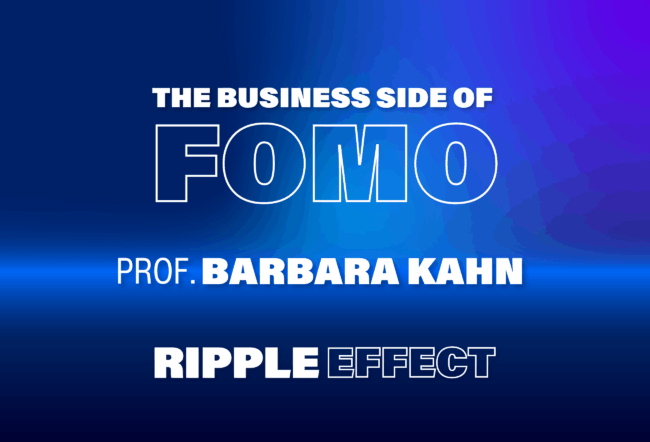Wharton marketing professor Leonard Lodish admits he is somewhat to blame for the erosion in brand pricing power that has hit many consumer-goods companies — but not entirely to blame.
In 1993, as store-level scanning data started to become widely available, Lodish coauthored an article outlining the power of this technology to gauge the effect of price promotions on revenue. However, he also warned that while these tools could be an effective way to measure the impact of discounting, they were not the only determinant of brand power. He insisted there are other long-term measures that may not be as easy to collect, but are just as important, perhaps more important, to sales, market share and stock price over time.
Brand managers heard the first part loud and clear. The second part? No so much. “People will go toward what is easy and precise, and shy way from the more difficult and complex,” says Lodish. “It’s human nature.”
Now, Lodish has written a new paper titled, “If Brands Are Built Over Years, Why Are They Managed Over Quarters?” with Carl F. Mela, a marketing professor at Duke University’s Fuqua School of Business. This paper shows how widespread adoption of easy-to-harness, short-term measures has altered consumer behavior and made it more difficult for brand managers to maintain pricing power and compete in the marketplace. “This paper says, ‘I told you so,'” Lodish states.
The authors point to research indicating that market share for branded products is declining, and that consumer sensitivity to price has increased in the past 25 years. Meanwhile, between 1978 and 2001, trade promotion spending — or discounts — has increased from 33% to more than 60% of marketing budgets. At the same time, spending for advertising, which is hard to link to sales but can build brand power more effectively over the long term, is down from 40% of marketing budgets to 24%.
Owning — Not Ceding — Your Customers
The authors reject the common contention that retail consolidation is to blame for pervasive margin erosion. They argue that in the 1990s, Vlasic (seller of pickles and other foods) caved into demands by Wal-Mart to cut its price, and eventually wound up in bankruptcy court. Meanwhile, Nike stood its ground when Foot Locker reduced its orders to protest changes in the running shoe manufacturer’s pricing and selection. Nike responded by cutting back its allocation of shoes to Foot Locker, which accounted for 10% of Nike’s sales. When customers could not find Nike shoes they wanted at Foot Locker, they moved on to competitors. Foot Locker eventually agreed to Nike’s terms. “Nike owned its customers while Vlasic ceded them to the channel,” the paper states.
Lodish says much of the trend toward promotional discounts may be attributed to scanner technology that emerged in the 1980s. The technology provided brand managers with data that clearly tracked the impact of price reductions by comparing stores that ran promotions against those that did not. In his earlier paper, written with Magid M. Abraham, who is now chief executive of the consumer research firm comScore, Lodish laid out models to use the data.
“They could see big increases in revenue, look at what they would have gotten without the promotion, and then look at their costs,” says Lodish. “Sometimes it was profitable and sometimes it wasn’t, but it was a way to get revenue up, and people were also concerned with market share. Once they started, they just kept doing it.”
Compounding the problem, he adds, was an increasing focus on short-term results by Wall Street analysts who were using the same data and models to value companies. Brand managers’ short job tenures also increased the emphasis on short-term results. “They don’t care about what happened two or three years ago,” Lodish says. “All they are thinking about is this quarter.”
Over time, consumers have adapted their behavior to reflect the new emphasis on discounts and eroding pricing power. “Consumers now lie in wait for a deal. If they are lying in wait for the next deal, they are not buying at the normal price,” says Lodish. Consumers have also learned to stockpile goods when they are on sale, diminishing full-price sales. Competitors, too, are now discounting. That leads consumers to purchase whichever brand is on sale at the time, eroding margins for all companies in the market.
Finally, constant sales diminish consumer perceptions of a brand. The authors point to K-Mart as an example: “A factor cited in K-Mart’s recent bankruptcy was its reliance on discounts to attract consumers to the store. When it endeavored to curtail these discounts, sales plummeted. What K-Mart had done was to make price the main reason that consumers shopped there, offering little intrinsic reason to be loyal to the store,” the paper states.
Short-term sales data tracking promotional effects don’t capture deeper impacts. The paper cites a study by Information Resources, Inc. (IRI), which reviewed 24 brands in Europe over a three-year period ending in 2005. The study found that the total impact of discounts was actually only 80% of their short-term effect, while the total effect of advertising could be as much as 60% greater than short-term measures would suggest.
The Wrong Way to Manage Data
The authors note that the nature of the data itself has an impact on marketing decisions that can actually impair brands over time. They interviewed managers at one firm who said they believe distribution and products play the greatest role in increased long-term sales. Yet the managers acknowledge they were focusing their marketing and research on advertising and discounting. When asked why, the managers said they are judged by quarterly sales, and that investors focus on those numbers because the link between discounts and quarterly sales is clear. “Thus, hard numbers drive out soft, leading managers to manage brands by the data they have, not the data they need,” the researchers write in their paper.
To correct some of these problems, Lodish and Mela put forth metrics to assess long-term prospects for a brand. They recommend every senior-level brand manager take a quarterly look at:
- The estimated brand sales at a constant, non-discounted price
- The change in baseline sales over months, quarters and years and the probability that the baseline sales have increased or decreased over those time periods
- The regular price and promoted price elasticity — or the percent change in revenue due to a percentage change in price
- Change in brand price response over months, quarters and years, and the probability that elasticity has increased or decreased.
If baselines are increasing and price response is decreasing, a brand is growing stronger and will be able to command full-price margins over time. If elasticity is growing and the baseline is decreasing, the brand is eroding. “By creating hard numbers about long-term effects, which are available as short-term metrics, firms can avoid some of the myopia inherent in their short-term measures,” the paper states.
The researchers cite one brand – LaCoste — that makes long-term equity a priority. The brand was a hit when it came to the United States in the 1950s and was still strong in 1969 when it was acquired by General Mills. In the mid-1980s, sales soared as General Mills lowered the price to extend distribution. However, the LaCoste name soon lost its caché when the once sought-after shirts wound up on discount racks and in clearance bins. In 1992, LaCoste repurchased the brand and promptly limited distribution, advertised through celebrities and raised prices. Initially, there was little impact on revenue, but from January 2002 through last year, sales were up 800%.
In the process of researching their paper, Lodish and Mela visited many companies and were astonished by the lack of longitudinal data collected by the firms. Many kept only 52 weeks of information. Furthermore, the researchers note, major data suppliers typically discard data after five years, while at the same time developing the capability to process hour-by-hour data. The authors acknowledge that hourly data will be useful as a way to monitor stock-outs. “However,” they continue, “it is difficult to imagine that local stock-outs affect market capitalization in the same way as brand equity, which often takes more than five years to build.”
In Praise of Clorox
The paper points to the example of Clorox as a leading consumer goods company that is at the head of the pack in using long-term metrics to protect its brand. Prior to 2005, Clorox was trapped in an endless cycle of discounting its flagship bleach product. Nearly once a month, the price was reduced to $0.99 at retail and advertising was cut. In the short-term, the strategy seemed to be profitable.
Yet consumers had learned to wait for the mark-downs, which resulted in declining baseline sales and high promotional lift — clear signs the brand was eroding. Clorox changed its strategy and reduced discounting while increasing advertising to build long-term loyalty and diminish consumer response to price. Initially, profits were down, but rebounded by the first half of 2006 along with long-term prospects for brand pricing power.
The authors show the implications for analysts who typically focus on quarterly revenue and other short-term figures. In the third quarter of 2005, an analyst might have downgraded the Clorox brand based on revenue and profit declines, yet would have missed the uptick in revenue and profits that came through in 2006 as a result of the new emphasis on brand-building.
“Short-term oriented measures, such as sales, should be supplemented with long-term metrics to obtain a more complete view of brand performance,” the authors write. “We believe this would offer a major step to redressing the weakening state of brands evidenced in recent years, increase our understanding of how strong brands can be built, and help firms do a better job of ‘owning’ their customers.”
If Brands Are Built Over Years, Why are they Managed Over Quarters?



